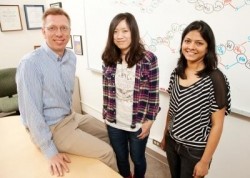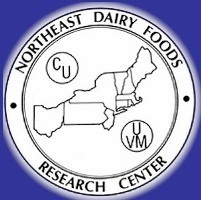New dairy analog antibiotic could improve food safety, US researchers find

Occurring naturally in milk, the antibiotic nisin is a product of bacteria resident in the cow’s udder, where it keeps milk from spoiling and kills a wide range of bacteria that cause foodborne illnesses such as Listeria monocytogenes and Clostridium difficile.
Lead researcher Prof. Wilfred van der Donk – whose team (pictured with him) has just published findings in the Proceedings of the National Academy of the Sciences – said that many people did not realise that nisin – approved as a food additive since 1969 – was added to foods, or that it occurred naturally in milk.
He said:“Last summer we had a listeria outbreak, and that’s a good example of people dying from pathogens in food. You don’t hear of such outbreaks often, and that’s in part because of the compounds that are added to food to kill the pathogens.”
Promise for bovine mastitis
Van der Donk noted nisin’s promise in treating bovine mastitis, which costs the dairy industry billions of dollars each year since milk produced during and shortly after antibiotic treatment needed to be thrown away.
Since nisin occurred naturally at low levels in milk, farmers using it to treat mastitis may not need to discard milk or meat from recently treated animals, he said.
But whereas nisin became unstable at higher temperatures, or at the neutral pH levels required for foods or pharmaceuticals, Van der Donk said that the new nisin analog did not.
The professor’s group said it had found genes, while studying another bacteria, and engineered a molecule with a similar structure and function to nisin that was more stable than the naturally occurring antibiotic.
Greater stability than nisin
Both nisin and geobacillin worked by binding to a molecule the pathogen needed to build its cell wall, then poking holes in the bacteria’s cell membrane, killing it.
But whereas nisin has five looped regions formed by cross-links in the protein chain, geobacillin had seven loops thanks to two additional cross-links, which lent it greater stability, the researchers found.
Van der Donk said: “Geobacillin is more stable, both in respect to pH and temperature, we think this is good news for potential use of geobacillin in food.”
The team tested geobacillin against several foodborne and disease-causing bacteria and said it was similarly or more effective than nisin, and was also three times more active against the main contagious bacteria responsible for bovine mastitis.
Next steps for the Illinois team involve testing geobacillin against a wider spectrum of disease-causing bacteria, as well as tests relating to safety and economic production, with the aim of developing medicinal applications.















